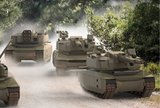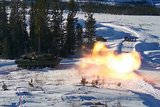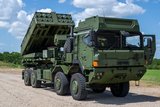Antifreeze and balaclavas: NATO troops in cold war games
‘This is my second time seeing snow, so it's a rather new experience,’ said a tank operative, a Florida native more accustomed to ice boxes than ice floes.
Like thousands of fellow US marines, Corporal Josye Martinez has been flown for military exercises to Norway, a country which pokes its head into the Arctic Circle.
It's not just the conditions that are frosty. These are NATO's biggest military exercises since the end of the Cold War, a fact which has upset Russia.
‘When I first landed in Norway, I was really cold, my body went into shock.... But as the time has gone by I've actually adapted to it’ said Martinez, perched in the turret of an Abrams tank.
The military exercises are taking place from 24 October to 7 November.
The manoeuvres are aimed at training the Atlantic Alliance to defend a member state after an aggression by a third party.
Worried about the ‘unpredictable’ behaviour of neighbouring Russia, especially since the Ukrainian crisis in 2014, Oslo had insisted on hosting Exercise Trident Juncture.
Some 50,000 troops, 65 ships and 250 aircraft from 31 countries are being deployed several hundred kilometres (miles) from Norway's border with Russia in the Arctic, leaving Russia vowing to ‘retaliate’.
Moscow has now announced plans to test fire missiles in international waters off Norway in its own show of strength, and proximity.
Meanwhile the fictional ‘Battle of Oppdal’ is underway, with US Marines pitted against Spanish and Italian troops over control of an airfield, very few of them accustomed to the biting cold.
For the Abrams tanks teams, based in North Carolina and more used to desert manoeuvres, operating their 60-tonne behemoth in the snow and ice is a challenge.
‘The driver has to be very careful because we can't always stop when we need to’ explains Lance Corporal Joaquin Medina, an ammunition loader aboard one the tanks, its colour and camouflage patterns standing out starkly in Norway's icy north.
‘Like two days ago, when it was very snowy and very icy, our tracks would just pedal. When we tried to stop, the tank would keep moving,’ he added.
On the ‘battlefield’ the thermometer shows relatively mild conditions for the time of year, six degrees Celsius (42 degrees Fahrenheit), minus one degree with the windchill factor.
Certainly cold enough for some of the US troops to stand behind their tanks to warm themselves from the engines air outlet.
‘A lot of people are from the southern states and in California where the coldest is usually around 70 degrees (Fahrenheit),’ said Janar Ploompuu, of the second armoured reconnaissance battalion, surrounded by colleagues bundled up against the cold and wearing thick white boots.
The army mechanics face another stern test -- making sure that the tanks hydraulics system don't freeze up.
The Lepanto mechanised battalion of the La Reina regiment, usually stationed in Cordoba, in sunny southern Spain, has been preparing in temperatures of minus 20 degrees Celsius (minus four degrees Fahrenheit) for the NATO exercises.
‘We have been training in the Pyrenees,’ said their commander, Lieutenant Colonel Gabriel Villalonga.
‘We have been taking driving lessons on snow, we have been in contact with our mountain school and have received lessons on how to move and live in such weather conditions,’ he added.
Already the US Marines have decided to deploy around 700 troops on rotation in Norway, independent of the current NATO exercises, to acclimatise its forces to operating in freezing conditions.
Several European armies are following suit.
‘We are ready to defend any NATO country or whatever country that needs our help,’ stressed Villalonga, braving the cold while his men enjoyed the relative warmth of their vehicles.
More from Land Warfare
-
![Hungary set to begin using Hero 400 loitering munitions]()
Hungary set to begin using Hero 400 loitering munitions
Developed by Israel's Uvision and with systems being sold in the thousands to multiple European NATO countries and the US, the Hero family of loitering systems is also in production in the US and Italy, the latter through Rheinmetall.
-
![Croatia orders Leopards and CAESAR howitzers as Lithuania orders more CAESARs]()
Croatia orders Leopards and CAESAR howitzers as Lithuania orders more CAESARs
The Leopard is becoming the tank of choice in central and eastern Europe as Croatia joins Lithuania, the Czech Republic and Hungary in ordering the platform. Lithuania and Croatia have also signed for CAESAR howitzers.
-
![Light Reconnaissance Strike – enabling a vital mission set (Studio)]()
Light Reconnaissance Strike – enabling a vital mission set (Studio)
A new system-of-systems concept will unlock digital integration of sensors and weapons for Light Forces, allowing them to shape the battlefield environment on their own terms and upgrade legacy platforms.
-
![Lockheed Martin to look further afield for GMARS rocket system opportunities]()
Lockheed Martin to look further afield for GMARS rocket system opportunities
The HX truck is already in use in many NATO and allied countries around the world as a logistics vehicle and carrier for high-value systems, including missile firing weapons, so its use for the Global Mobile Artillery Rocket System makes logistical sense.























